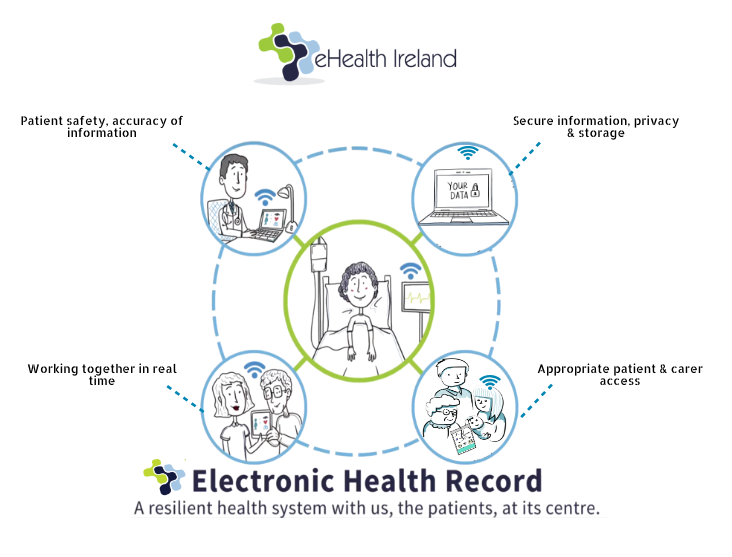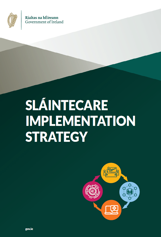What is an Electronic Health Record (EHR)?
Electronic Health Records (EHR) replace traditional paper based health and social care records with a comprehensive medical record in electronic form that captures care encounters for an individual across different healthcare providers. An EHR system supports the recording, updating and retrieving of information in the electronic health record and allows healthcare providers to deliver care more effectively. It will enable the sharing of key patient information effectively in Irish healthcare and will support health and social care professionals in delivering care to patients.

Why move to a national EHR?
An EHR system will move us from a position where key information and patient records are locked in a paper format across multiple healthcare providers, to an environment where electronic patient records are shared securely across care settings with appropriate consent.
When adopted across the healthcare system, the Electronic Health Record system will transform the delivery of health and social care by creating shared patient records that are the primary information source for all health and social care professionals and will result in:
- better, safer clinical decision making,
- more informed and engaged patients and citizens,
- integration of services across care settings,
- increased availability of information to enable proactive management of patients and conditions,
- improved patient outcomes.
“EHR for Ireland will change health care & empower both clinicians & patients...This will support better, safer clinical decision-making and a more connected health service delivering improved health outcomes.” - Minister for Health, Simon Harris TD

What is the EHR Programme?
The EHR Programme is a series of projects aimed at the delivery of a national Electronic Health Record across Ireland. The EHR Programme comprises four elements:
- Acute EHR– to provide capabilities that serve the needs of acute hospitals.
- Community EHR– to provide core capabilities across Community Healthcare Organisations and services including health and well-being, social care, primary care and mental health.
- Shared Record – to incorporate the key information across healthcare ICT systems and make it available to care providers and patients to enable the coordination and planning of care.
- Integration Capability - to facilitate the flow of information along the continuum of care.
What national strategies does the EHR Programme support?
SláinteCare

Sláintecare Implementation Strategy
The Oireachtas Committee on the Future of Healthcare Sláintecare report (2017), presents a vision for a new health service in Ireland, re-orienting healthcare service delivery in Ireland towards a high quality integrated system. It identifies the shift towards primary and community based care as an essential element in addressing the challenges within our existing Health Care system. The report focuses on moving the focus of treatment from acute hospitals to the community and home via digital and technology enabled innovations. A key enabler to delivering the vision outlined in the Sláintecare report is the establishment of an EHR solution. It states that there should be "Continued strong support of the e-health strategy - particularly ensuring the necessary funding for timely roll-out of the EHR system". In order to implement the Sláintecare vision, the Irish Government in 2108 released a Sláintecare Implementation Strategy designed around 4 key strategic goals and 10 high level strategic actions. Two strategic actions which the EHR Proramme will specifically support are:
Sláintecare Strategic Action 4 - "Expand community-based care to bring care closer to home."
- Develop an enabling environment for joined-up community working including ICT, data, clinical governance, patient safety and quality operating frameworks and systems.
Sláintecare Strategic Action 10 - "Put in place a modern eHealth infrastructure and improve data, research and evaluation capabilities."
- Implement the national acute Electronic Health Record (EHR), starting with the new National Children’s Hospital.
- Design and roll out community-based Electronic Health Records, connecting data across the system and, over time, making data available to patients.
- Design and roll out a range of primary and community-based ICT services that will improve the lives of patients, including ePrescribing, summary care records (Shared Record) and commence implementing telehealth solutions to support care in the community.
National development plan 2018-2027
National Development Plan 2018-2027
"The National Development Plan will support the provision of digital health services, including the development of electronic health records in many health care settings such as the New Children’s Hospital over the 10-year implementation timescale and reflects what was envisaged in the eHealth strategy for Ireland. This vision is also set out and supported in the Sláintecare report. Digital health services will enable the right information about the right patients to be available securely in the right health care setting at the right time. This will allow doctors and nurses to enhance patient safety and will also support, in time, patients being able to securely access their own health data."
- National Development Plan 2018-2027
For more detail on the background to the EHR Programme please click here:


